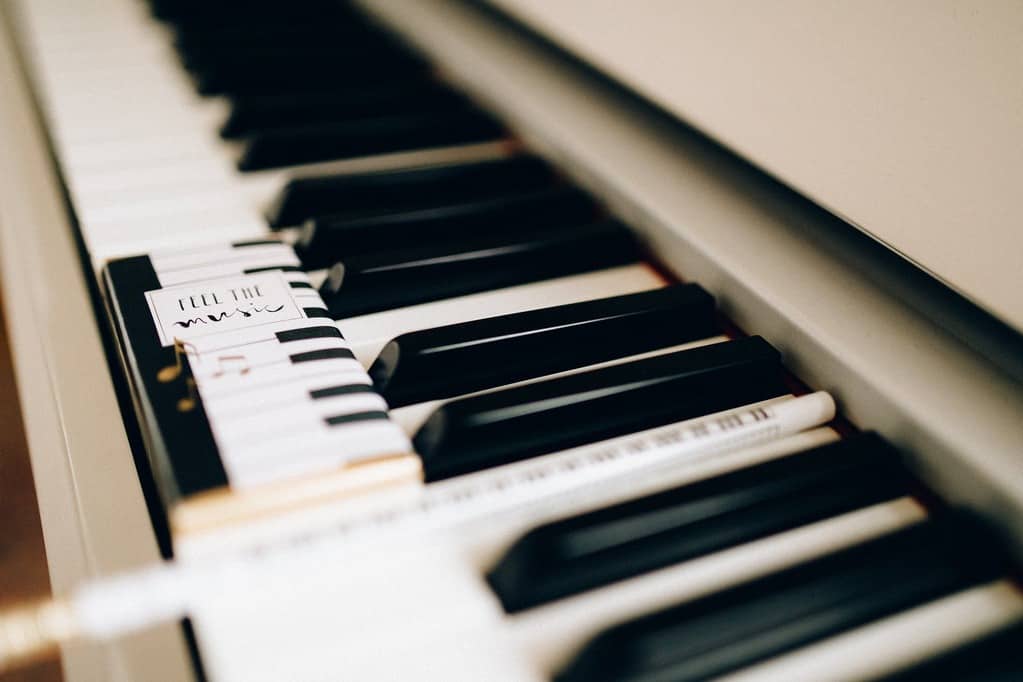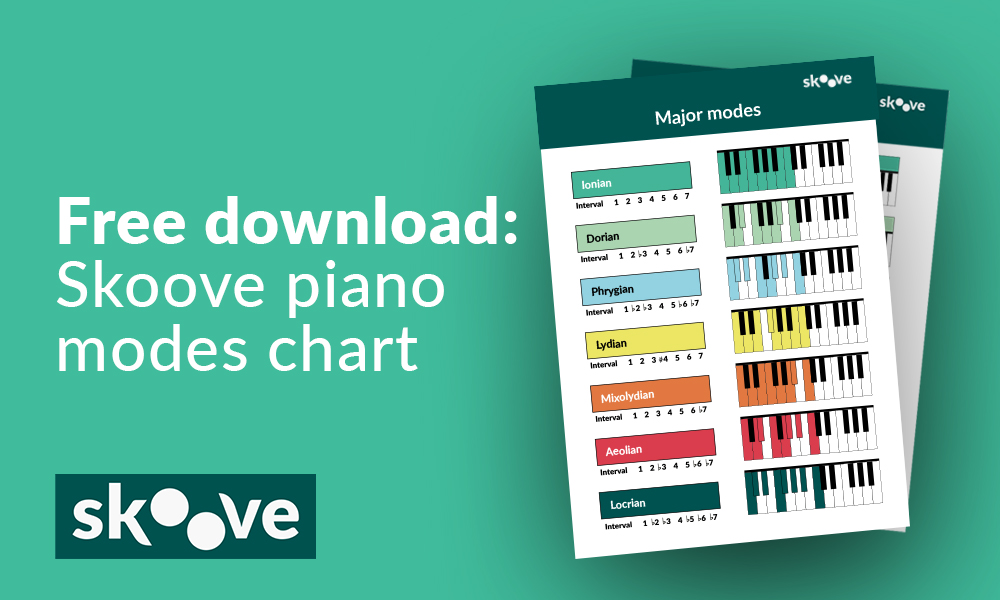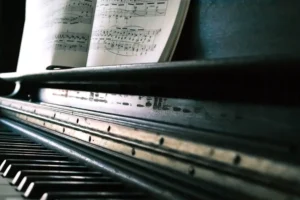Modes are part of the basic building blocks of Western music theory. If you’ve ever heard a music teacher talk about modes you may well have noticed that they all have Greek names. These musical modes come from the earliest days of music history. Put simply, a mode is a type of scale, just like in the song ‘doh re mi fa so la ti do’ from The Sound of Music. If we change just one of these notes, we can call the scale a mode. Each mode evokes its own mood and has a unique color and sound. In fact, you probably know a lot more about modes than you realize.
- Fall in love with the music - Learn your favorite songs, at a level suitable for you.
- Enjoy interactive piano lessons - Explore courses covering music theory, technique chords & more.
- Get real-time feedback - Skoove's feedback tells you what went well and what needs practice.

What are musical modes?
Modes in music are scale-like patterns that can start on any note within the scale, not just the root. Each of the modes have their own unique sound, character and flavors, adding depth and color to musical composition. Originating from some of the earliest forms of Western music, modes can be traced back to Ancient Greece. As you progress in learning piano, modes will become increasingly essential, enriching your understanding and expanding your creative options. If you need the musical modes explained further this article is the place for you!
What are the differences between scales & modes?
A piano scale is a sequence of notes arranged by pitch in a specific order. Each scale has a unique interval pattern between notes that defines its character. For instance, the interval pattern for a major scale is:
Tone, Tone, Semitone, Tone, Tone, Tone, Semitone.
Following this pattern from C gives us: C D E F G A B
Modes, on the other hand, are variations of a scale that start on different scale degrees. To understand this, take the C major scale (also known as the ionian mode) and shift the starting note to the second degree, D.
Playing D to D with the same notes as C gives us the Dorian mode: D E F G A B C D
Modes are like rotations or inversions of the parent scale, each with a unique mood and character. We’ll explore different ways to understand and apply modes in this article.
History of musical modes
Musical modes have been around long before the major or minor scales were developed. They originated in Ancient Greece where the modes were named after different regions. The Ancient Greek modes were slightly different to those of more recent centuries: some names are the same (like Mixolydian or Dorian) but others are slightly different (like Hypolydian or Hypophrygian).
There is a common misconception that church modes of medieval Europe were direct descendants of these Ancient Greek modes. But the church modes were in fact developed in the ninth century. These modes were heavily used in church music, especially in what is known as Gregorian Chant music. Over time, these Gregorian modes were gradually replaced by chromatic scales and diatonic scales (also known as diatonic modes). Certainly, from the time of J. S. Bach onwards most music was written in keys (for example, C major, D minor etc.). Modes are still incredibly relevant in music today particularly in the field of jazz music, due to the unusual and otherworldly sounds that jazz modes can create.
Modes in the context of C major
A good rule of thumb is to know that each mode can be played with the white keys on a piano, using the notes of the C major scale. You can see that the modes are always named after the note they start on and then labeled with a Greek name.
Altering scales to create modes
One way to work out a mode is to know how they relate to the major or minor scale. If you change one or two steps in a major or minor scale step pattern, you can convert them into a different mode. First, let’s look at modes linked to the major scale.
| Mode | Alterations to Scale | Notes |
|---|---|---|
| C Ionian | 1-2-3-4-5-6-7-1 No alterations. Same thing as the major scale. | C-D-E-F-G-A-B-C |
| C Dorian | 1-2-b3-4-5-6-b7-1 | C-D-Eb-F-G-A-Bb-C |
| C Phrygian | 1-b2-b3-4-5-b6-b7-1 | C-Db-Eb-F-G-Ab-Bb-C |
| C Lydian | 1-2-3-#4-5-6-7-1 | C-D-E-F#-G-A-B-C |
| C Mixolydian | 1-2-3-4-5-6-b7-1 | C-D-E-F-G-A-Bb-C |
| C Aeolian | 1-2-b3-4-5-b6-b7-1 Same thing as the natural minor scale. | C-D-Eb-F-G-Ab-Bb-C |
| C Locrian | 1-b2-b3-4-b5-b6-b7-1 | C-Db-Eb-F-Gb-Ab-Bb-C |
First let’s look at modes containing a major 3rd: Lydian and Mixolydian.
Lydian
Take any major scale and raise the fourth note a half step.
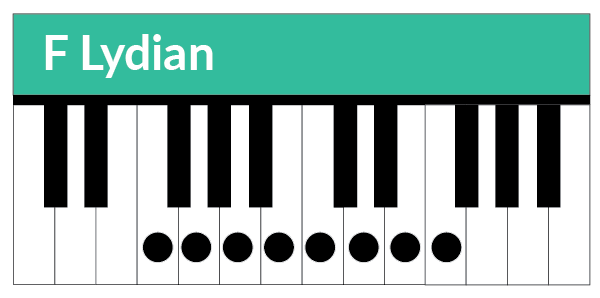
Lydian is the brightest sounding musical mode. To play this mode, take any major scale and raise the 4th note a half step. So, in C major this would contain the notes:
C D E F♯ G A B C
This raised fourth degree gives a bright but interesting sound. A well known example of this is the theme to The Simpsons
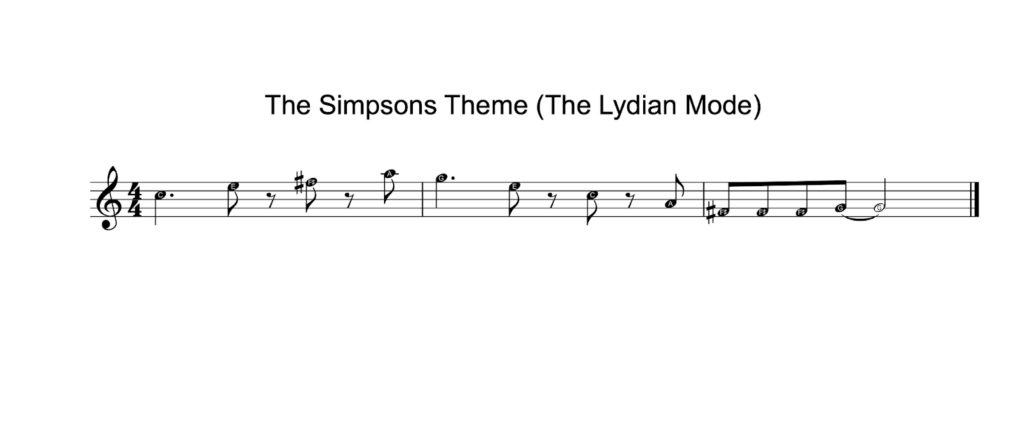
Mixolydian
Take any major scale and lower the seventh note a half step.
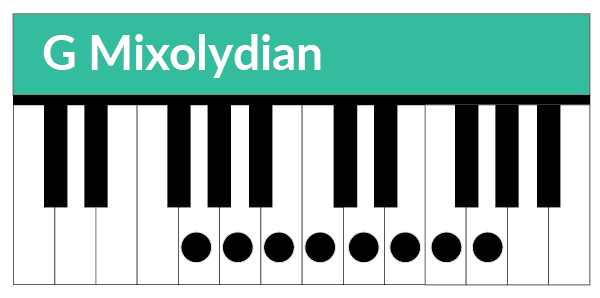
Mixolydian is a vibrant mode that brings a slightly bluesy, relaxed feel. To play in Mixolydian, start with any major scale and lower the 7th note by a half step. For example, in C Mixolydian, the notes are:
C D E F G A B♭ C
This lowered seventh (B♭ instead of B) gives Mixolydian its distinct sound, blending the brightness of the major scale with a hint of tension.
A well-known example of Mixolydian is Sweet Home Alabama

This has a tonic chord of d while the melody operaties in G major giving a mixolydian feel.
Next let’s dive into the four minor modes Dorian, Phrygian, Aeolian and Locrian and explore their unique characteristics, how to play them, and where they’re used in music.
Dorian
Take any major scale and lower the seventh and third notes a half step.
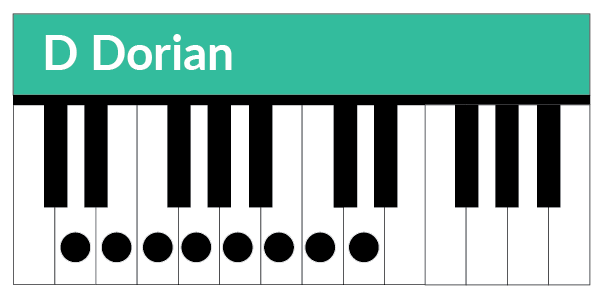
Dorian mode is a minor scale with a brighter twist, thanks to its raised 6th (from the natural minor) note. This mode is perfect for creating music that feels minor but with a hopeful edge.
C D E♭ F G A B♭ C
Aeolian mode
Take any major scale and lower the seventh, third and sixth notes a half step.
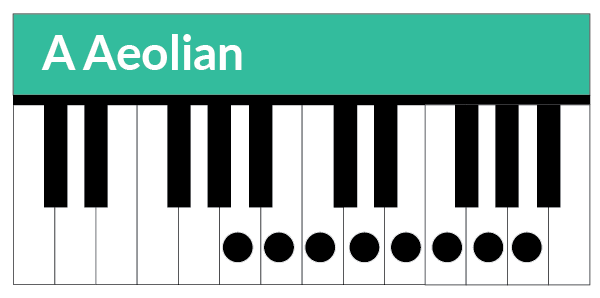
C D E♭ F G A♭ B♭ C
Aeolian mode is the natural minor scale, the most familiar and widely used of all the minor modes. Its melancholic, expressive sound fits across genres. A great example of this mode in action is Bethoven’s Moonlight Sonata. Have a go at playing it today on the Skoove app.
Phrygian mode
Take any major scale and lower the seventh, third, sixth and second notes a half step.
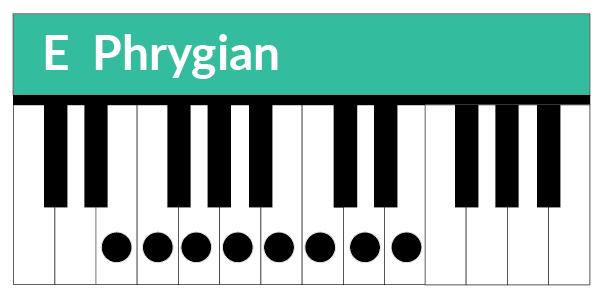
C D♭ E♭ F G A♭ B♭ C
Phrygian mode is a dramatic and exotic scale, characterized by its flattened 2nd note. It’s perfect for creating tension and drama, often evoking a Spanish or Middle Eastern feel.
Locrian mode
Take any major scale and lower the seventh, third, sixth, second and fifth notes a half step.
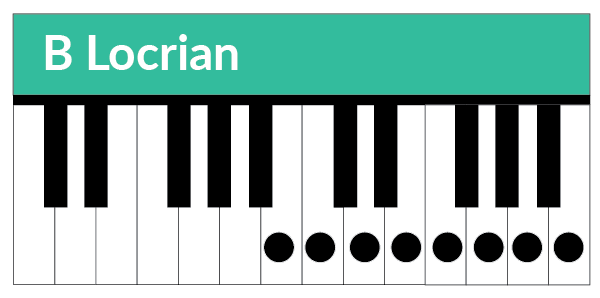
C D♭ E♭ F G♭ A♭ B♭ C
Locrian mode is the most unstable and rarely used mode. Its flattened 2nd and 5th notes create an unsettling and dissonant quality, making it ideal for dramatic or experimental music.
Parent scales
Knowing how modes relate to each scale is a great way of progressing your understanding of scales and music theory as a whole. Another way to work out a mode is to reference the order of modes in the table below. Once you know this, you can work backwards to find its parent scale.
| Key | Ionian | Dorian | Phrygian | Lydian | Mixolydian | Aeolian | Locrian |
|---|---|---|---|---|---|---|---|
| C Major | C | D | E | F | G | A | B |
| G Major | G | A | B | C | D | E | F# |
| D Major | D | E | F# | G | A | B | C# |
| A Major | A | B | C# | D | E | F# | G# |
| E Major | E | F# | G# | A | B | C# | D# |
| B Major | B | C# | D# | E | F# | G# | A# |
| F Major | F | G | A | Bb | C | D | E |
| Bb Major | Bb | C | D | Eb | F | G | A |
| Eb Major | Eb | F | G | Ab | Bb | C | D |
| Ab Major | Ab | Bb | C | Db | Eb | F | G |
| Db Major | Db | Eb | F | Gb | Ab | Bb | C |
| Gb Major | Gb | Ab | Bb | Cb | Db | Eb | F |
Using the table above, you can see that Lydian is the 4th note of the major scale. So, if you want to work out what the D Lydian scale is, you need to think about which scale contains D as the 4th note.
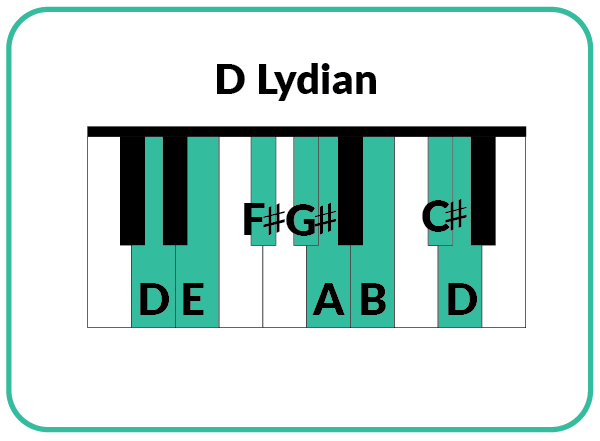
The answer is A Major which has three sharps C, F and G. This means that D Lydian also has these three sharps to create D major with a raised 4th degree.
Using the table above, you can see that Mixolydian is the 5th note of the major scale. To figure out what the G Mixolydian scale is, you need to identify the major scale in which G is the 5th note.
The answer is C Major, which has no sharps or flats. This means that G Mixolydian also has no sharps or flats, creating a G major scale with a lowered 7th degree.
Organizing modal sounds
Understanding these qualities will improve your perception of modes and how their distinct characteristics can alter a piece of music. Organizing modes from “brightest” to “darkest” shifts from the most open, uplifting sounds to those with a somber, tense quality. Here’s the list from bright to dark:
- Lydian (Brightest) – Lydian is the brightest mode, due to its raised fourth, which gives it a dreamy, expansive quality. This mode feels more uplifting than the major scale and often creates an airy, bright sound.
- Ionian (Major) – The Ionian mode, identical to the major scale is a bright, happy, and familiar sound. It’s the foundational scale in Western music that conveys joy and clarity.
- Mixolydian – Mixolydian is a major scale with a lowered seventh, this adds a subtle bluesy edge that tempers its brightness. It’s commonly used in rock and folk music for its relaxed, optimistic feel.
- Dorian – Dorian is a minor mode with a natural sixth, making it feel brighter than Aeolian but still grounded in a minor tonality. This mode’s balanced sound works well in jazz and blues, where it conveys a soulful, melancholic but hopeful quality.
- Aeolian (Natural Minor) – Aeolian, or the natural minor scale, is the classic minor scale with a melancholic, introspective sound. It is darker than Dorian but still balanced, making it versatile for expressing sadness or emotional depth.
- Phrygian – Phrygian has an exotic and mysterious quality due to its minor tonality and lowered second. It is common in Spanish and Middle Eastern music and evokes a brooding, dark character.
- Locrian (Darkest) – Locrian is the darkest mode, with a diminished fifth that gives it a highly crunchy, unstable sound. Rarely used as a primary mode, Locrian’s dissonance creates an unsettling unresolved feeling.
Try playing through the musical modes in order and notice what you hear; from Lydian’s bright, uplifting qualities to Locrian’s tense, dark dissonance, each mode offers unique atmospheres and emotional depth, showcasing the possibilities of modal interchange in music.
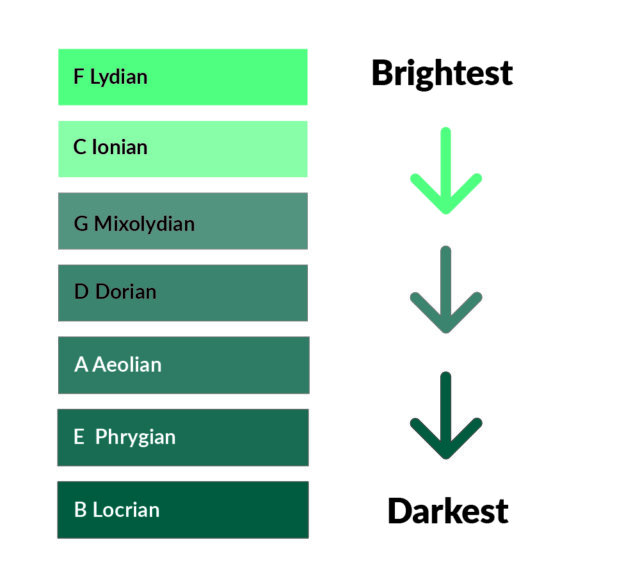
Famous songs that use musical modes
Ionian: Countless famous songs are written in the Ionian mode (the major scale). The song ‘Piano Man’ by Billy Joel is one of many that you can learn, but you’ll find countless other examples of songs that use the Ionian mode on the Skoove App.
Learn how to play ‘Piano Man’ by Billy Joel. Start a 7 day trial today – no card details required!
Aeolian: Aeolian is probably the second most used mode in pop and dance music, because it is the same as the natural minor scale. Here on Skoove you can learn how to play the natural minor scale in the song ‘Back to Black’ by Amy Winehouse.
Learn how to play ‘Back to Black’ by Amy Winehouse. Start a 7 day trial today – no card details required!
Mixolydian: The Mixolydian mode is great when it comes to playing blues music. The mixolydian scales use all the tones that make up a dominant 7th chord – the chord type that is used in most blues chord progressions. You can learn more about the dominant 7th chord by playing the song ‘Bouncy Boogie’ on Skoove. As an extension to this lesson try incorporating some of the notes from the Mixolydian mode:
Learn how to play ‘Bouncy Boogie’ on piano. Start a 7 day trial today – no card details required!
The song ‘Praise You’ by Fatboy Slim also makes use of the Mixolydian mode. You can learn how to play it right here on the Skoove App!
Learn how to play ‘Praise You’ by Fatboy Slim. Start a 7 day trial today – no card details required!
Multiple modes: Kraftwerk’s hit song ‘Das Model’ is a really interesting song to learn, because it uses a combination of modes. You can learn how to play this song here on Skoove. See if you can notice how it begins in the Aeolian mode (there is no F or F# in the melody), but then it moves to the Dorian mode in the middle section.
Learn how to play ‘Das Model’ by Kraftwerk. Start a 7 day trial today – no card details required!
More examples of modes in use
Reddit users often have discussions on modes on r/music theory, here you can see a varied list of popular music that makes use of modes. You can also explore Scooves’ wide ranging catalog of lessons and pieces and see what modes you can find for yourself.
What are some popular modern songs in modes other than Ionian and Aeolian?
byu/Therealslimshamop inmusictheory
Incorporating modes into my piano playing
The best way to explore and understand musical modes is hands-on, with a keyboard at your fingertips. If a physical keyboard isn’t available, a virtual piano can be an excellent alternative. You may be surprised to discover that if you’ve played any classical or popular music, you’ve likely encountered modes already! Experimenting with different modes on a keyboard allows you to feel how each mode shapes the foundation of a melody and helps you anticipate the unique character each mode brings.
Musical modes have been integral to music since ancient times, continuing to influence church music, classical compositions, and jazz improvisation. To dive deeper into the functions and versatility of modes, try out a free trial of Skoove today and experience the world of modes firsthand!
Author of this blog post
Vicki Young

Vicki Young is a pianist and singer with a degree in Music from the University of Sheffield. She lives in London, UK with her husband and son. Vicki is a communications and marketing freelancer who has worked with a range of organizations across the music and charity sectors.
Published by Lydia Ogn from the Skoove team







